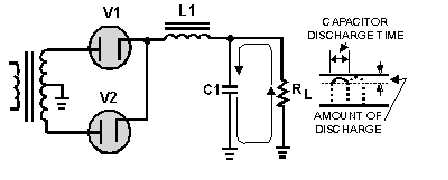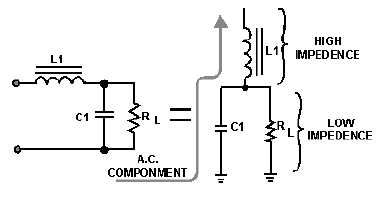3-25
As a result, when the pulsating voltage is first applied to the LC choke-input filter, the inductor or
filter choke (L1) produces a counter emf that opposes the constantly increasing input voltage. The net
result is to effectively prevent the rapid charging of the filter capacitor (C1). Thus, instead of reaching the
peak value of the input voltage, C1 only charges to the average value of the input voltage. After the input
voltage reaches its peak and decreases sufficiently, the capacitor (C1) attempts to discharge through the
load resistance (RL). C1 will attempt to discharge as indicated in figure 3-29. Because of its relatively
long discharge time constant, C1 can only partially discharge.
Figure 3-29.—LC choke-input filter (discharge path).
The larger the value of the filter capacitor, the better the filtering action. However, due to the
physical size, there is a practical limitation to the maximum value of the capacitor.
The inductor or filter choke (L1) maintains the current flow to the filter output (capacitor C1 and
load resistance RL) at a nearly constant level during the charge and discharge periods of the filter
capacitor.
The series inductor (L1) and the capacitor (C1) form a voltage divider for the ac component (ripple)
of the applied input voltage. This is shown in figure 3-30. As far as the ripple component is concerned,
the inductor offers a high impedance (Z) and the capacitor offers a low impedance. As a result, the ripple
component (Er) appearing across the load resistance is greatly attenuated (reduced). Since the inductance
of the filter choke opposes changes in the value of the current flowing through it, the average value of the
voltage produced across the capacitor contains a much smaller value of ripple component (Er), as
compared with the value of ripple produced across the coil.
Figure 3-30.—LC choke-input filter (as voltage divider).



